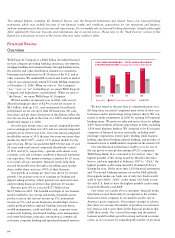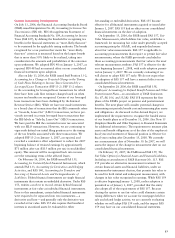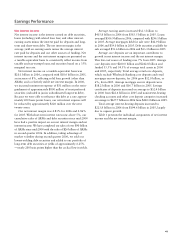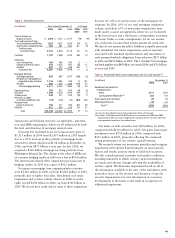Wells Fargo 2006 Annual Report Download - page 41
Download and view the complete annual report
Please find page 41 of the 2006 Wells Fargo annual report below. You can navigate through the pages in the report by either clicking on the pages listed below, or by using the keyword search tool below to find specific information within the annual report.
39
Given that the majority of our loan portfolio is consumer
loans, for which losses tend to emerge within a relatively
short, predictable timeframe, and that a significant portion
of the allowance for credit losses relates to estimated credit
losses associated with consumer loans, management believes
that the provision for credit losses for consumer loans, absent
any significant credit event, will closely track the level of
related net charge-offs. From time to time, events or economic
factors may impact the loan portfolio, as Hurricane Katrina
did in 2005 and 2006, causing management to provide
additional amounts or release balances from the allowance
for credit losses.
Valuation of Residential Mortgage Servicing Rights
We recognize as assets the rights to service mortgage loans
for others, or mortgage servicing rights (MSRs), whether we
purchase the servicing rights, or the servicing rights result
from the sale or securitization of loans we originate (asset
transfers). We also acquire MSRs under co-issuer agreements
that provide for us to service loans that are originated and
securitized by third-party correspondents. Effective January 1,
2006, under FAS 156, Accounting for Servicing of Financial
Assets – an amendment of FASB Statement No. 140, we
elected to initially measure and carry our MSRs related to
residential mortgage loans (residential MSRs) using the fair
value measurement method. Under this method, purchased
MSRs and MSRs from asset transfers are capitalized and
carried at fair value. Prior to the adoption of FAS 156, we
capitalized purchased residential MSRs at cost, and MSRs
from asset transfers based on the relative fair value of the
servicing right and the residential mortgage loan at the time
of sale, and carried both purchased MSRs and MSRs from
asset transfers at the lower of cost or market. Effective
January 1, 2006, upon the remeasurement of our residential
MSRs at fair value, we recorded a cumulative effect adjust-
ment to increase the 2006 beginning balance of retained
earnings by $101 million after tax ($158 million pre tax)
in stockholders’ equity.
At the end of each quarter, we determine the fair value
of MSRs using a valuation model that calculates the present
value of estimated future net servicing income. The model
incorporates assumptions that market participants use in
estimating future net servicing income, including estimates
of prepayment speeds, discount rate, cost to service, escrow
account earnings, contractual servicing fee income, ancillary
income and late fees. The valuation of MSRs is discussed
further in this section and in Note 1 (Summary of Significant
Accounting Policies), Note 20 (Securitizations and Variable
Interest Entities) and Note 21 (Mortgage Banking Activities)
to Financial Statements.
To reduce the sensitivity of earnings to interest rate and
market value fluctuations, we may use securities available
for sale and free-standing derivatives (economic hedges) to
hedge the risk of changes in the fair value of MSRs, with the
resulting gains or losses reflected in income. Changes in the
fair value of the MSRs from changing mortgage interest rates
are generally offset by gains or losses in the fair value of the
derivatives depending on the amount of MSRs we hedge and
the particular instruments chosen to hedge the MSRs. We
may choose not to fully hedge MSRs, partly because origina-
tion volume tends to act as a “natural hedge.” For example,
as interest rates decline, servicing values decrease and fees
from origination volume tend to increase. Conversely, as
interest rates increase, the fair value of the MSRs increases,
while fees from origination volume tend to decline. See
“Mortgage Banking Interest Rate Risk” for discussion of the
timing of the effect of changes in mortgage interest rates.
Net servicing income, a component of mortgage banking
noninterest income, includes the changes from period to
period in fair value of both our residential MSRs and the
free-standing derivatives (economic hedges) used to hedge
our residential MSRs. Changes in the fair value of residential
MSRs from period to period result from (1) changes in the
valuation model inputs or assumptions (principally reflecting
changes in discount rates and prepayment speed assumptions,
mostly due to changes in interest rates) and (2) other changes,
representing changes due to collection/realization of expected
cash flows. Prior to the adoption of FAS 156, we carried
residential MSRs at the lower of cost or market, with amor-
tization of MSRs and changes in the MSRs valuation
allowance recognized in net servicing income.
We use a dynamic and sophisticated model to estimate
the value of our MSRs. The model is validated by an
independent internal model validation group operating in
accordance with Company policies. Senior management
reviews all significant assumptions quarterly. Mortgage loan
prepayment speed—a key assumption in the model—is the
annual rate at which borrowers are forecasted to repay their
mortgage loan principal. The discount rate used to determine
the present value of estimated future net servicing income—
another key assumption in the model—is the required rate
of return investors in the market would expect for an asset
with similar risk. To determine the discount rate, we consider
the risk premium for uncertainties from servicing operations
(e.g., possible changes in future servicing costs, ancillary
income and earnings on escrow accounts). Both assumptions
can, and generally will, change quarterly valuations as
market conditions and interest rates change. For example,
an increase in either the prepayment speed or discount rate
assumption results in a decrease in the fair value of the
MSRs, while a decrease in either assumption would result
in an increase in the fair value of the MSRs. In recent years,
there have been significant market-driven fluctuations in loan
prepayment speeds and the discount rate. These fluctuations
can be rapid and may be significant in the future. Therefore,
estimating prepayment speeds within a range that market
participants would use in determining the fair value of MSRs
requires significant management judgment.
These key economic assumptions and the sensitivity of the
fair value of MSRs to an immediate adverse change in those
assumptions are shown in Note 20 (Securitizations and
Variable Interest Entities) to Financial Statements.
























